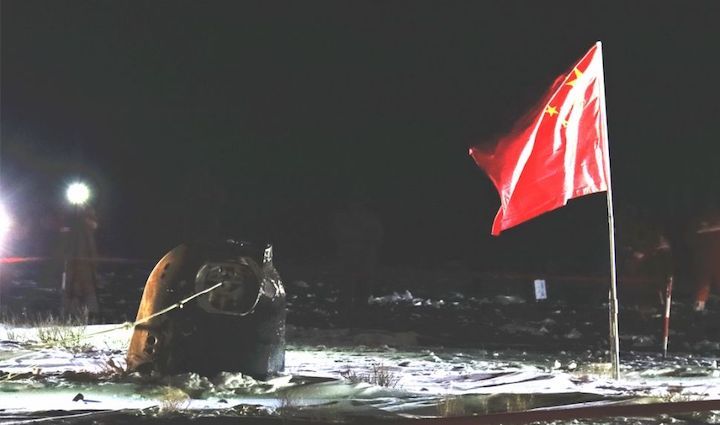10.07.2021

China's Chang's 5 return capsule with samples of the moon is seen after landing in Inner Mongolia, China, on Dec. 17, 2020. (Image credit: CASC)
China is preparing a follow-up to its audacious Chang'e 5 lunar sample return mission by sending a similar spacecraft to collect material from the South Pole-Aitken (SPA) basin on the far side of the moon.
China launched Chang'e 5 in November last year and 23 days later recovered a return capsule containing samples of what could be the youngest lunar rocks so far collected. That mission's backup, Chang'e 6, is now being prepared for an even more challenging sampling attempt on the far side of the moon in 2024.
Hu Hao, chief engineer of the China Lunar Exploration and Space Engineering Center, announced in a statement released on China's national space day in April this year that the Chang'e 6 probe, consisting of an orbiter, lander, lunar ascent vehicle and reentry capsule, will target the South Pole-Aitken (SPA) basin.The SPA basin is a colossal, ancient impact crater roughly 1,550 miles (2,500 kilometers) in diameter that covers almost a quarter of the moon's far side. The impact basin, considered to be the oldest on the moon, holds vital clues about the history of the moon and the solar system, according to a new report.
Previously, the U.S. National Academy of Sciences proposed a similar mission targeting the SPA basin as a priority research interest in its Vision and Voyages for Planetary Science in the Decade 2013-2022 report released in 2011.
China's Chang'e 4 lander and the Yutu 2 rover made the first-ever landing on the far side of the moon in 2019 and they are currently exploring and returning datafrom the landing area in Von Kármán crater, within the SPA basin.
But being able to analyze rocks from this area back on Earth would help determine the age of the giant impact basin and provide insight into the history of the formation of the moon and more.
Chinese authorities have not revealed the precise landing site within the.SPA basin, which extends from Aitken crater at 18 degrees south all the way down to the lunar South Pole and contains many large craters, such as Apollo, which could offer flat yet intriguing landing areas.
The Chang'e 6 mission will also carry a number of payloads from international partners. France will provide a detection instrument named DORN for studying the element radon and how it outgasses from the lunar regolith.
Italy's National Institute of Nuclear Physics (INFN) will provide a laser retroreflector, an instrument used to bounce light back to its source, allowing scientists to measure the time taken for the journey and convert the information into an accurate distance. The Apollo 11, 14, and 15 missions all carried laser-ranging retroreflectors.
Other contributions have been preliminarily selected from Russia and Sweden, Hu Hao said in the statement. The joint China-Russia instrument will investigate the potential presence of surface water ice while the Swedish contribution would focus on detecting negative ions.
Chang'e 5 was China's first lunar sample mission, following the Chang'e 1 and 2 orbiters and the landers and rovers of the Chang'e 3 and 4 missions. Chang'e 6 is being listed as an early part of a joint project with Russia to establish an International Lunar Research Station.
The far side of the moon never faces Earth, so Chang'e 6 will need the help of a relay satellite beyond the moon to communicate with the planet. This is because of tidal locking, which occurs when a planet's gravity slows the rotation of a moon so much that it takes the same time for a moon to rotate as it does for it to orbit its planet. The Queqiao satellite has performed this relay role for Chang'e 4 and could also assist Chang'e 6.
Quelle: SC
